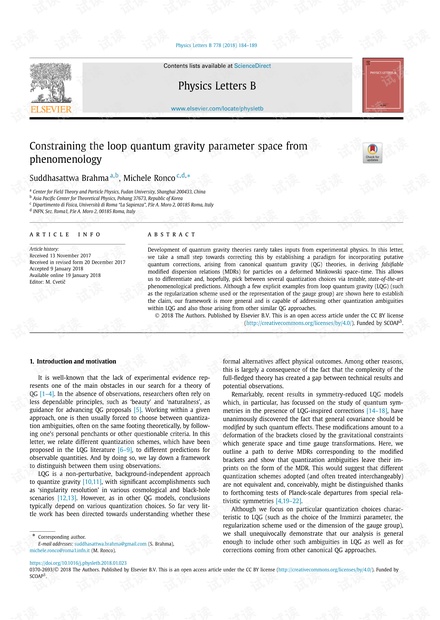没有合适的资源?快使用搜索试试~ 我知道了~
量子引力理论的发展很少吸收实验物理学的投入。 在这封信中,我们迈出了一步,通过建立一种范式来整合推论,该推论由规范量子引力(QG)理论产生,用于推导变形的Minkowski时空上的粒子的可证伪的修正弥散关系(MDR)。 。 这使我们能够通过可检验的最新现象学预测来区分并希望在多个量化选择之间进行选择。 尽管此处显示了一些来自环路量子引力(LQG)的显式示例(例如使用的正则化方案或量规组的表示)来确立权利要求,但我们的框架更加通用,能够解决LQG内的其他量化歧义 以及其他类似QG方法产生的结果。
资源推荐
资源详情
资源评论

Physics Letters B 778 (2018) 184–189
Contents lists available at ScienceDirect
Physics Letters B
www.elsevier.com/locate/physletb
Constraining the loop quantum gravity parameter space from
phenomenology
Suddhasattwa Brahma
a,b
, Michele Ronco
c,d,∗
a
Center for Field Theory and Particle Physics, Fudan University, Shanghai 200433, China
b
Asia Pacific Center for Theoretical Physics, Pohang 37673, Republic of Korea
c
Dipartimento di Fisica, Università di Roma “La Sapienza”, P.le A. Moro 2, 00185 Roma, Italy
d
INFN, Sez. Roma1, P.le A. Moro 2, 00185 Roma, Italy
a r t i c l e i n f o a b s t r a c t
Article history:
Received
13 November 2017
Received
in revised form 20 December 2017
Accepted
9 January 2018
Available
online 19 January 2018
Editor:
M. Cveti
ˇ
c
Development of quantum gravity theories rarely takes inputs from experimental physics. In this letter,
we take a small step towards correcting this by establishing a paradigm for incorporating putative
quantum corrections, arising from canonical quantum gravity (QG) theories, in deriving falsifiable
modified
dispersion relations (MDRs) for particles on a deformed Minkowski space–time. This allows
us to differentiate and, hopefully, pick between several quantization choices via testable, state-of-the-art
phenomenological
predictions. Although a few explicit examples from loop quantum gravity (LQG) (such
as the regularization scheme used or the representation of the gauge group) are shown here to establish
the claim, our framework is more general and is capable of addressing other quantization ambiguities
within LQG and also those arising from other similar QG approaches.
© 2018 The Authors. Published by Elsevier B.V. This is an open access article under the CC BY license
(http://creativecommons.org/licenses/by/4.0/). Funded by SCOAP
3
.
1. Introduction and motivation
It is well-known that the lack of experimental evidence rep-
resents
one of the main obstacles in our search for a theory of
QG [1–4]. In the absence of observations, researchers often rely on
less dependable principles, such as ‘beauty’ and ‘naturalness’, as
guidance for advancing QG proposals [5]. Working within a given
approach, one is then usually forced to choose between quantiza-
tion
ambiguities, often on the same footing theoretically, by follow-
ing
one’s personal penchants or other questionable criteria. In this
letter, we relate different quantization schemes, which have been
proposed in the LQG literature [6–9], to different predictions for
observable quantities. And by doing so, we lay down a framework
to distinguish between them using observations.
LQG
is a non-perturbative, background-independent approach
to quantize gravity [10,11], with significant accomplishments such
as ‘singularity resolution’ in various cosmological and black-hole
scenarios [12,13]. However, as in other QG models, conclusions
typically depend on various quantization choices. So far very lit-
tle
work has been directed towards understanding whether these
*
Corresponding author.
E-mail
addresses: suddhasattwa.brahma@gmail.com (S. Brahma),
michele.ronco@roma1.infn.it (M. Ronco).
formal alternatives affect physical outcomes. Among other reasons,
this is largely a consequence of the fact that the complexity of the
full-fledged theory has created a gap between technical results and
potential observations.
Remarkably,
recent results in symmetry-reduced LQG models
which, in particular, has focussed on the study of quantum sym-
metries
in the presence of LQG-inspired corrections [14–18], have
unanimously discovered the fact that general covariance should be
modified by such quantum effects. These modifications amount to a
deformation of the brackets closed by the gravitational constraints
which generate space and time gauge transformations. Here, we
outline a path to derive MDRs corresponding to the modified
brackets and show that quantization ambiguities leave their im-
prints
on the form of the MDR. This would suggest that different
quantization schemes adopted (and often treated interchangeably)
are not equivalent and, conceivably, might be distinguished thanks
to forthcoming tests of Planck-scale departures from special rela-
tivistic
symmetries [4,19–22].
Although
we focus on particular quantization choices charac-
teristic
to LQG (such as the choice of the Immirzi parameter, the
regularization scheme used or the dimension of the gauge group),
we shall unequivocally demonstrate that our analysis is general
enough to include other such ambiguities in LQG as well as for
corrections coming from other canonical QG approaches.
https://doi.org/10.1016/j.physletb.2018.01.023
0370-2693/
© 2018 The Authors. Published by Elsevier B.V. This is an open access article under the CC BY license (http://creativecommons.org/licenses/by/4.0/). Funded by
SCOAP
3
.
资源评论

weixin_38696339
- 粉丝: 4
- 资源: 908
上传资源 快速赚钱
 我的内容管理
展开
我的内容管理
展开
 我的资源
快来上传第一个资源
我的资源
快来上传第一个资源
 我的收益 登录查看自己的收益
我的收益 登录查看自己的收益 我的积分
登录查看自己的积分
我的积分
登录查看自己的积分
 我的C币
登录后查看C币余额
我的C币
登录后查看C币余额
 我的收藏
我的收藏  我的下载
我的下载  下载帮助
下载帮助

 前往需求广场,查看用户热搜
前往需求广场,查看用户热搜最新资源
资源上传下载、课程学习等过程中有任何疑问或建议,欢迎提出宝贵意见哦~我们会及时处理!
点击此处反馈



安全验证
文档复制为VIP权益,开通VIP直接复制
 信息提交成功
信息提交成功